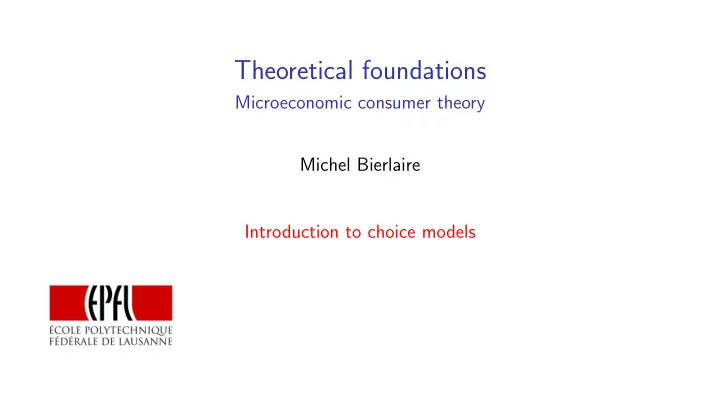

Theoretical foundations Microeconomic consumer theory Michel Bierlaire Introduction to choice models
The case of discrete goods
Microeconomic theory of discrete goods The consumer ◮ selects the quantities of continuous goods: Q = ( q 1 , . . . , q L ) ◮ chooses an alternative in a discrete choice set i = 1 , . . . , j , . . . , J ◮ discrete decision vector: ( y 1 , . . . , y J ), y j ∈ { 0 , 1 } , � j y j = 1. Note ◮ In theory, one alternative of the discrete choice combines all possible choices made by an individual. ◮ In practice, the choice set will be restricted for tractability
Example Choices ◮ House location: discrete choice ◮ Car type: discrete choice ◮ Number of kilometers driven per year: continuous choice Discrete choice set Each combination of a house location and a car is an alternative
Utility maximization Utility � z T y ) U ( Q , y , ˜ ◮ Q : quantities of the continuous good ◮ y : discrete choice z T = (˜ ◮ ˜ z J ) ∈ R K × J : K attributes of the J alternatives z 1 , . . . , ˜ z i , . . . , ˜ ◮ ˜ z T y ∈ R K : attributes of the chosen alternative ◮ θ : vector of parameters
Optimization problem � z T y ) max U ( Q , y , ˜ Q , y subject to p T Q + c T y ≤ I � j y j = 1 y j ∈ { 0 , 1 } , ∀ j . where c T = ( c 1 , . . . , c i , . . . , c J ) is the cost of each alternative Solving the problem ◮ Mixed integer optimization problem ◮ No optimality condition ◮ Impossible to derive demand functions directly
Solving the problem Step 1: condition on the choice of the discrete good ◮ Fix the discrete good, that is select a feasible y . ◮ The problem becomes a continuous problem in Q . ◮ Conditional demand functions can be derived: q ℓ | y = demand( I − c T y , p , ˜ z T y ) , or, equivalently, for each alternative i , q ℓ | i = demand( I − c i , p , ˜ z i ) . ◮ I − c i is the income left for the continuous goods, if alternative i is chosen. ◮ If I − c i < 0, alternative i is declared unavailable and removed from the choice set.
Solving the problem Conditional demand functions demand( I − c i , p , ˜ z i ) , i = 1 , . . . , J Conditional indirect utility functions Substitute the demand functions into the utility: U i = � U (demand( I − c i , p , ˜ z i ) , ˜ z i ) = U ( I − c i , p , ˜ z i ) , i = 1 , . . . , J
Solving the problem Step 2: Choice of the discrete good � J U ( I − c T y , p , ˜ z T y ) s.t. max y i = 1 . y i =1 ◮ Enumerate all alternatives. ◮ Compute the conditional indirect utility function U i . ◮ Select the alternative with the highest U i . ◮ Note: no income constraint anymore.
Model for individual n U ( I n − c T z T max n y , p n , ˜ n y ) y Simplifications ◮ S n : set of characteristics of n , including income I n . ◮ Prices of the continuous goods ( p n ) are neglected. ◮ c in is considered as another attribute and merged into ˜ z n z n = { ˜ z n , c n } . max U in = U ( z in , S n ) i
Recommend
More recommend